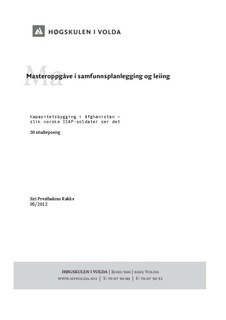| dc.description.abstract | Summary
The study looks at the mission in Afghanistan and specifically the ISAF-led force and its objectives. The research examines the objective of capacity building of Afghans in Afghanistan from ISAFs point of view, and discuesses whether this has been successful from Norwegian soldiers´perspectives.
The mission in Afghanistan has changed focus between the time international forces entered the country in 2001 and the present day. The mission initially targeted a fight against the Taliban and finding the people responsible for the terrorist attacks on America on September 11, 2001. Today the mission focuses mainly on capacity building and accountability of the Afghans in line with vision extraction, with an end goal of largely withdrawing forces by the end of 2014.
From a military standpoint, the mission in Afghanistan has been twofold. The initial offensive, Operation Enduring Freedom, to the ISAF-led operation that dominates today. OEF was primarily directed against removing the Taliban from power and then to stem the tide of terror by destroying camps and support facilities used for education and training of Al-Qaeda supporters, and to arrest well known leaders of this network. The ISAF-led operation is a cooperation between different nations, and it is formally led by NATO. These two operations have been ongoing in parallel for many years, and Norwegian soldiers have participated under the leadership of both.
In this study, interviews were conducted with six Norwegian soldiers who have deployed a total of 14 times to Afghanistan. Thus, the study is based on qualitative data, and social science. All six soldiers belong to the Army and all were officers at the time of the interviews. The term soldier is used freely througout the study, however, as this is a generally accepted terminology. The Norwegian total commitment in Afghanistan has been both military and humanitarian, but this study is limited to the military perspective.
The study: It begins with a short overview of the ISAF, before the chosen theory is reviewed. Throughout, Stein Rokkan´s models around nation building are considered significant, and discussion is built around Rokkans four phases of nation building. It is also referenced around capacity building, especially when based on Roar Amdam´s models. Furthermore, the research deals with a host of supporting literature by Astri Suhrke, Øivind Østerud and Kai Eide.
During the interviews, the soldiers brought up topics that were not necessarily explicitly stated in the interview guide. This included workload on Army personnel, which highlighted some of the challenges faced during assignments in Afghanistan to date. These kinds of additional topics that engaged the soldiers will be mentioned in the study. The soldiers were also asked to consider whether they have witnessed concrete capacity building measures, and their answers are examined especially in the empirical chapter.
Committee for this study is small, and therefore no attempt is made to generalise since the foundation is too weak. Given the qualitative focus, many interesting points arise around the soldiers´sense of mission in Afghanistan and their personal experiences. The result suggests that the soldiers are skeptical about whether Afghanistan on their own will be able to handle the challenges they might face after 2014. | no_NO |
